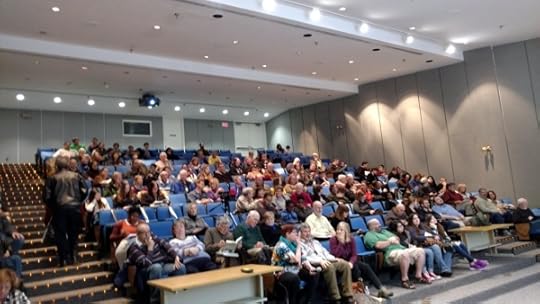Chad Orzel's Blog, page 11
February 16, 2016
166/366: Overkill
It’s been a ridiculously mild winter here, with occasional bursts of extreme cold. The last few days, we’ve gotten about as much snow as we’ve gotten all winter, which is not a terribly impressive amount:
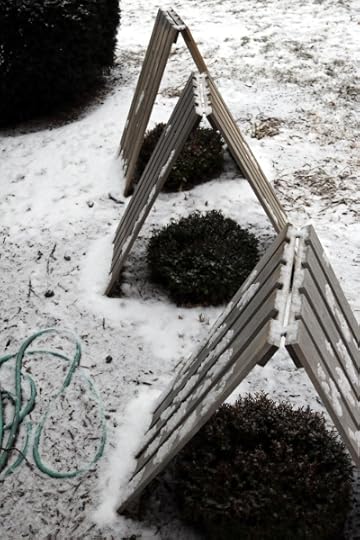
Our front bushes, fully protected against snow damage.
These bushes sit right under the bow window in front of our house, and a few years ago snow sliding off the roof crushed them pretty good. so I got these heavy wooden frames to protect them. Which has been a little excessive this year, but if I didn’t set them up when doing the other winterizing activities I do every fall, I’d completely forget them until after we got a heavy snow, and then they’d get crushed again.
Anyway, as this is one of the very few opportunities I’ll get this year to photograph snow, I figured I should take it…
Attempted Mpemba Effect
One of my favorite modern tales of scientific discovery is the Mpemba Effect, named after Erasto Mpemba, a schoolboy in Tanzania who noticed while making ice cream that hot mix put in the freezer solidified faster than cold. This counter-intuitive result has been replicated a bunch of times, and physicists and chemists continue to debate the reason for it.
It was bitterly cold this weekend, dipping down into the negative Fahrenheit, which wasn’t great for, you know, leaving the house, but did provide an opportunity to test the Mpemba Effect. Because when the icy winds of winter blow, that’s a great time to do SCIENCE!…
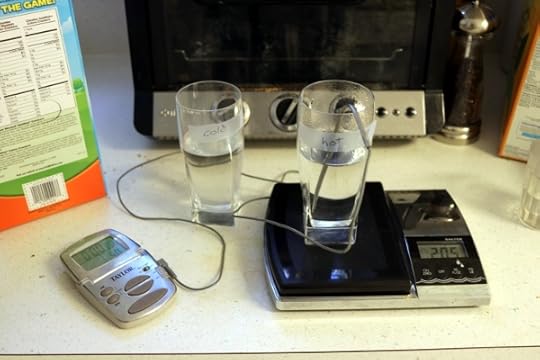
Materials for an attempt to observe the Mpemba Effect.
One of the tricky things about the Mpemba Effect is quantifying what it means for hot liquid to freeze faster than cold, but I thought of a way to (attempt to) handle that, which was another reason for running the test. So I grabbed a couple of water glasses out of the cabinet, and filled one with 200g of filtered tap water at 18C, and the other with filtered tap water heated in the microwave, at 81C. The water glasses had a mass of about 350g; there’s a +/-5g error on all those masses, because the cheap kitchen scale we have at home only reads to the nearest 5g.
Then, I took the two glasses and put them out on the patio table:
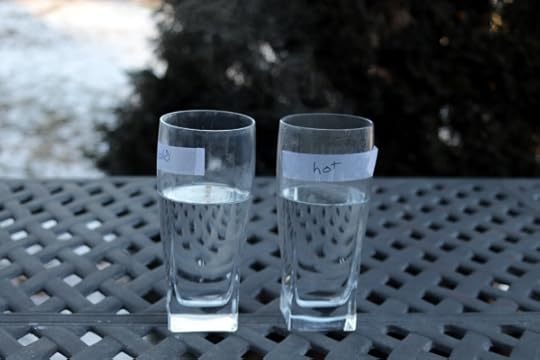
Starting condition for a science experiment.
(Actually, I put them like this for the photo, then separated them a little more, just to make sure that there wasn’t any thermal contact between the samples…)
I left them outside for about two hours, which was long enough for them to partially freeze, but not completely:
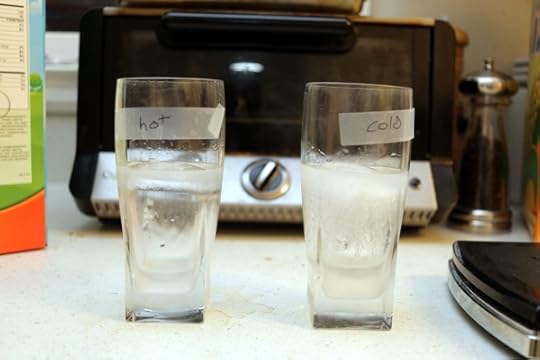
Frozen water from the Mpemba Effect experiment.
I weighed the two glasses again, and found that the hot water had lost some mass– the total mass was about 540g, so 10g down from the start. This was presumably due to evaporation– you can just see a cloud of steam rising from it in the outdoor photo. The cold water didn’t lose any mass, continuing to register at 550g, though again: cheap kitchen scale.
To get at the amount of freezing, I took a steak knife and chopped a hole in the top layer of ice in each glass, then poured out the liquid water from underneath. Then I weighed the glasses again: the cold water glass plus solid ice clocked in at 455g, and the hot water glass with ice at 420g.
To put that in terms of a freezing fraction, the cold water had 105g of ice out of 200 g of water, or 53% ice, and the hot water had 70g of ice in 190g of water, so 37% ice.
So, as an attempt to observe the Mpemba Effect, this was pretty much a complete failure. Alas. This isn’t entirely surprising, though, as the effect is notoriously finnicky. Which is why it’s been argued about in the literature for 40-odd years. I thought about repeating the trial with slightly different conditions– one of the things you see in a lot of the discussions of this is a comparison between water that was heated and allowed to cool before being put in the freezer and water that was put in the freezer while hot. The idea being that heating may drive off some impurities, changing the water a bit. I didn’t try that on Sunday because I was in a hurry to set it up before dinner and the kids’ bedtime, and we got snow on Monday that would’ve messed up the conditions. But it’s something I’ll keep in mind for the next time it’s unpleasantly cold…
February 15, 2016
165/366: Wintry Science
It was bitterly cold over the weekend here in the Northeast, with daytime high temepratures in the single digits Fahrenheit. This has little to recommend it in terms of, you know, leaving the house, but it did provide an opportunity to try some SCIENCE!
Unfortunately, I left the notepad with the data (such as it is) on it at home when I came to Starbucks to write, so I can’t do the detailed write-up. I’ll use it for the photo of the day, though, from which you can probably guess what I was trying to do:

Starting condition for a science experiment.
Detailed explanation of methods and results later today, or maybe tomorrow.
163-164/366: Recurring Themes
This weekend’s photos were mostly of the kids, and mostly had other people’s kids in them, as they did a double play-date on Saturday afternoon. I’m going to lump two days together, because they’re really just repeating previous themes. Here are the kids eating dinner at the Union women’s basketball game Friday night:
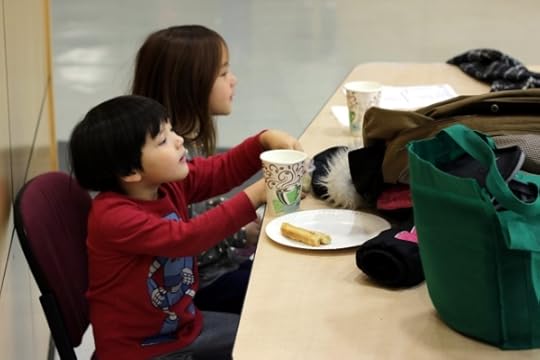
SteelyKid and The Pip eating dinner at a basketball game.
(They went absolutely bonkers after this– it’s hard to describe how hyped up they were Friday.)
And here’s yet another fort:

SteelyKid watching tv from inside the tunnel fort she built on the couch.
This one was relatively small, just the cushions from our living-room couch piled up and covered with a blanket to make two small “rooms” connected by a “tunnel.” This was endlessly entertaining for SteelyKid, though, who was especially fired up to lie in her “room” to eat breakfast and watch cartoons.
So, how was your weekend?
February 13, 2016
162/366: The Love Fishtank
SteelyKid was sent home on Wednesday with strep throat, and so needed to be home thursday as well. she was very disappointed to be missing school, as her class was preparing for a Valentine’s Day party on Friday. I picked up a bunch of work for her, including a heart-shaped paper pouch to hold the cards the kids would exchange.
You wouldn’t’ve known she was officially sick on Thursday– her energy level was basically at normal. She powered through a bunch of homework, and then set to decoarting the pouch with hearts and happy stick figures in a rainbow of colors. And also a fishtank:
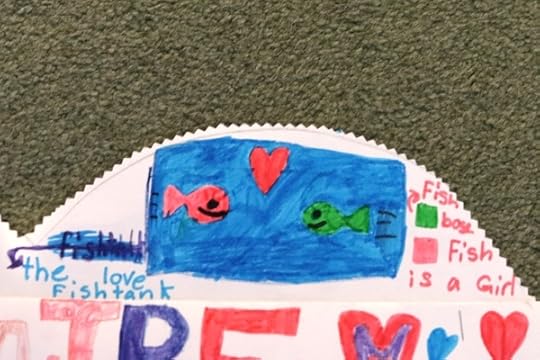
Detail from SteelyKid’s heart-shaped pouch for Valentine’s Day cards.
I’m not sure why love has a fishtank, but I’m glad to see she’s not confined by conventional Valentine iconography…
More seriously, her teacher also had the kids write a note to each of their classmates saying something nice about them. SteelyKid had finished all but one of these before she was sent home, so I mostly don’t know what she wrote, but the booklet of messages to her from other kids is ridiculously cute and charming. She’s apparently widely regarded as funny and “wise” (a sort of odd word choice, which must’ve come from something they read as a class), and about a third of them mention the “Zoom Day” when she donned sparring gear and let all her classmates punch her in the chest. As a physicist, I was also happy to see that one classmate wrote “I hope you can teach me your math tricks”…
It was a really sweet class project, and must’ve taken really careful management by the teacher. But it came out great, so I continue to be very impressed with her school.
February 12, 2016
161/366: Mobile Office
Some time back, I posted a photo of my usual spot at the Starbucks in Niskayuna. When I was in Newport News earlier this week, of course, I had to find a different space from which to rant about Twitter. Here’s that spot:
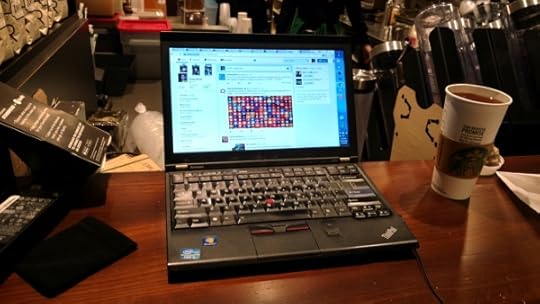
My “office” when I was in Virginia.
As you can see, the principal difference between the two is that I didn’t bring my stainless-steel travel mug with me on the trip. The store in Newport News is laid out almost exactly the same way as my regular one in Niskayuna.
I’m probably more amused by this than any of my readers will be, but then, this was the only remotely photo-worthy thing in a long annoying day of air travel on Wednesday. So.
February 10, 2016
160/366: Nice Crowd
I did bring my good camera with me to Newport News, and took it on the tour of Jefferson Lab yesterday, but despite the existence of DSLR pics, you’re getting a cell-phone snap for the photo of the day:
That’s the audience about 10-15 minutes before my talk last night, so it was a good turnout. And they laughed in the right places, and asked some really good questions last night. I also got asked to appear in a selfie with a bunch of students from a local school, so they could prove they were there to get extra credit for their science class…
The talk went well, though we had some technical difficulties. The shiny new video projection system in the auditorium has an audio input jack on the VGA cable for the laptop input, but it’s about four inches long, and the headphone jack for my laptop is on the far side of the keyboard from the VGA out. Whoops.
We ended up taping a lapel mike to the desk right under the laptop speaker, which was mostly fine, except for a couple of occasions where we got earsplitting feedback. Technology, man. What can you do? Video will be posted to the JLab web site at some point in the future, after they edit it and get closed captions done (I’m very sorry for whoever has to do that…)
I was also pleasantly surprised that a couple of Williams classmates showed up to the talk (they live in the area), so I went out with them afterwards for a couple of beers, to catch up. All in all, a good day.
Now, I just need to get through most of a day of airports and Regional Jets to get home to Niskayuna.
February 9, 2016
Twitter Is a Cocktail Party That I’m Not Invited To
As I go through my daily routine, I find myself sort of out of phase with a lot of the Internet. My peak online hours are from about six to ten in the morning, Eastern US time. That’s when I get up, have breakfast, and then go to Starbucks to write for a few hours.
This means that most of the other people awake and active on my social media feeds are in Europe or Australia. And my standard writing time ends right around the time things start to heat up in the US. I do continue to have access to the Internet through the afternoon, of course, but unless I have a deadline coming up, I’m often doing stuff that doesn’t involve sitting in front of a computer (and if I do have a deadline coming up, I shut down social media to concentrate on work). And evenings are terrible– I spend a lot of weeknights running SteelyKid to various activities, and even when I’m not doing that, our dinner and bedtime routines don’t leave me much space to participate. By nine or ten pm, I’m completely wiped out.
As a result, I find Twitter a deeply frustrating medium. Twitter is mostly about conversation, but its deliberately ephemeral nature means that you can really only converse effectively with other people who are online and active at the same time you are. And the peak activity times for Twitter conversations are at times when I’m not regularly available because of the way my work and family schedules are arranged. In those peak hours, I’m only checking in intermittently– a few times an hour, usually– and as a result, I miss tons of stuff.
I started thinking about this the other day, when there was a big kerfuffle over Twitter’s plan to introduce an “algorithmic” timeline that would depart from the current strictly-chronological display to highlight some posts from the past. This predictably led to wailing and gnashing of teeth among Twitter power users (and it’s since been walked back a little), who declared that it would be the end of Twitter as we know it. Personally, though, I think it might be a good thing, which led to this lengthy tweetstorm, which you’ll notice was posted at 8am on a Saturday, because that’s when I have time to be on Twitter…
The standard line is that any deviation from strictly chronological Twitter will hopelessly break things in one of a variety of ways, but this is largely predicated on the assumption that the algorithm will be the stupidest and most obnoxious thing you could dream up. But, really, it’s not that hard to do a better job than most of the people outraged about the idea seem to think.
Take, for example, Facebook. Facebook famously switched to an algorithmic timeline a while back, and most of the anti-algorithm arguments feature dark mutterings about how this will make Twitter just like Facebook. To an intermittent social-media user like me, though, Facebook is in many ways better than Twitter. I have slightly more Facebook friends than people I follow on Twitter (about 750 vs just under 600), but Facebook does a better job of highlighting stuff I want to see. I regularly find tweets from Rhett Allain because he has his feed mirrored to Facebook, and the Facebook algorithm knows I like his stuff and makes sure I see it. On Twitter, in the middle of the day, his tweets get lost in a vast flood of stuff that I don’t get to check very often. At the same time, if I’m actively on Facebook for a relatively long time, the feed I see is pretty much chronological.
The other insinuation is that under an algorithmic scheme only stuff from famous tweeters will get shown, or paid ads. But again, I’m not convinced, because Twitter already has an algorithmic feature, the “While You Were Away” box that pops up when you go several hours without checking in. That was roundly condemned when it was introduced for basically the same reasons, but again, I find that it does a good job of highlighting stuff I wouldn’t see otherwise. And it’s not just getting me massively-retweeted stuff from clickbait outlets. One of the people who pops up most frequently in my “While You Were Away” tab is a guy with under 400 followers, because I like a good deal of his stuff, and the algorithm knows that. I find that feature one of the most useful things Twitter has done recently, and would be happy to have it show up more regularly. And given that they do that well, I’m not especially worried about what would happen with a wider use of algorithms.
Of course, the fundamental issue isn’t anything about practical implementation, but rather that the current power users like Twitter as it is, because it works well for them. Which, you know, good for them, but it should be noted that this is fundamentally pretty exclusionary. That is, the way Twitter is set up right now works really well for a particular set of people, who have the sort of jobs and family arrangements such that they’re online and actively engaged at the same time as their friends. It’s big among journalists, for example, because their whole business is about being connected, and science Twitter is dominated by folks in fields whose research mostly has them sitting in front of a computer already. If you’re not lucky enough to be in that particular demographic stratum, though, the current experience of Twitter is much less attractive.
I’ve heard Twitter described as a virtual cocktail party before, and it’s a decent metaphor– lots of people hanging around, engaged in conversation and witty banter. I would note, though, that the usual analogy doesn’t go far enough. For an intermittent user like myself, Twitter is like a really cool cocktail party that I’m not invited to. It’s a bit like the party is spilling out of bar into the lobby of my hotel– I catch snatches of cool conversations as I make my way to the elevator, but I miss most of it because I have other stuff to do. Every now and then, I get a chance to hang out in the bar for a bit, and that’s great, but mostly I’m getting second-hand reports and that’s just not the same.
And it should be noted that I am, in fact, relatively fortunate as such things go. I do have a few hours in the morning where I’m able to participate, and I sometimes get the chance to do more. In the cocktail party metaphor, I’m at least staying in the same hotel with most of the partygoers. The folks in other hotels don’t get even that much, which is why so many people continue to not see the point of Twitter.
The kinds of changes Twitter is talking about making could, if implemented well, make the medium more accessible for those who are currently shut out. It won’t completely open things up– it’s always going to be a conversational medium, and conversation will always require time for engagement– but good algorithms could make it easier for people who aren’t already part of the conversation to see why those who are find it useful and enjoyable.
Of course, as it is, there’s very much a “cool kids” dynamic to Twitter, and a lot of the reaction is best understood in that light. The experience of Twitter that the current power users enjoy is a relatively exclusive one, and Twitter is choosing to pursue broadening access to the service over enhancing the experience of those who already use it heavily. Nothing I’ve heard described is going to shut out anybody who’s already in, though– at most, they’re going to be inconvenienced to a small fraction of the degree that non-power-users are already inconvenienced.
Most of the Bad Things people trot out as results of algorithmic timelines are things that I already put up with as an intermittent Twitter user. Bits of conversation will appear out of context? If you only check in a few times an hour, you already get that (and because otherwise very smart people can’t figure out how to properly thread conversations, there’s often no good way to reconstruct what’s going on, but that’s another rant). You might miss things posted by your friends? That happens now, given the huge flood of stuff that comes in at peak hours– as mentioned above, I have to rely on Facebook’s algorithms to rescue a lot of stuff that gets lost in the noise on Twitter. Your stuff might just vanish without the right people seeing it? That already happens to those of us who are out-of-phase with peak Twitter activity.
All of these negative features are annoyances that people who aren’t on the inside already have to put up with. And given sensibly designed algorithms– which my experience with Facebook and “While You Were Away” suggests are entirely possible– these can be minimized. Done right, they have the potential to make Twitter more attractive and enjoyable for a lot of people who don’t currently get anything out of it.
159/366: Thanks, Manitoba
I’m in Newport News, VA, to give a talk tonight at Jefferson Lab, and they’re putting me up at the on-site Residence Facility. The rooms at this are apparently sponsored associated with institutions that use the facility, with big signs on all the doors. Here’s mine:
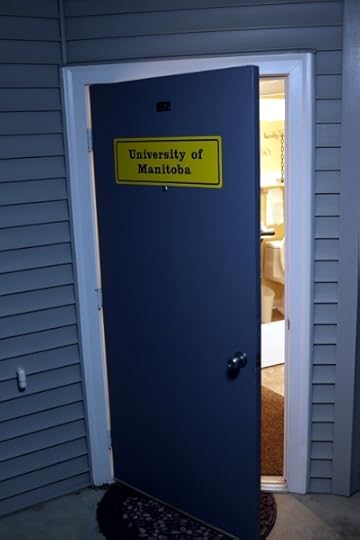
Door to my room at JLab’s Residence Facility.
So, I guess my stay is in some sense subsidized by the University of Manitoba. It’s a perfectly adequate hotel room, so, thanks, Manitoba.
As I am a Sooper Geeenyus, I forgot to pack the dress pants I usually wear when giving talks. Sigh. Happily, this is a public lecture, so jeans-and-sport-coat is a perfectly acceptable outfit. But I still feel like a dope…
February 8, 2016
158/366: Fort
Since our recent trip to Vermont, SteelyKid has been obsessed with building blanket forts. These have mostly been in the living room, leading to a bit of angst at the end of the day when we need the blankets back. So i did a little reorganizing in the basement, and dug some sheets out of storage, allowing the construction of a longer-duration fort.

The blanket fort du jour in the basement of Chateau Steelypips.
This covers the basement comprehensively enough that it’s probably a little hard to appreciate how much stuff is inside. The critical thing, though, is that SteelyKid is satisfied with the result:

SteelyKid inside the basement blanket fort.
Chad Orzel's Blog
- Chad Orzel's profile
- 89 followers


